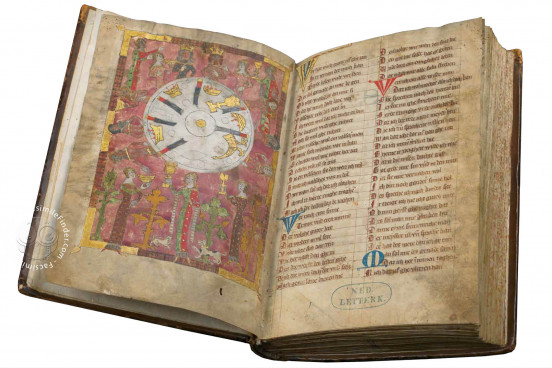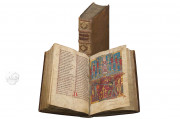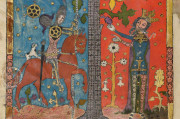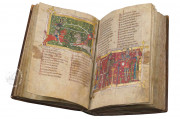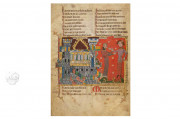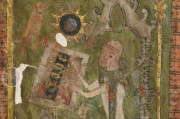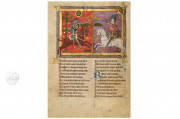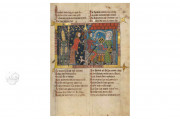The Leiden Wigalois is the most extensively illuminated manuscript of the Middle High German poetic Arthurian romance named for its protagonist by Wirnt von Grafenberg. Created at the behest of Albrecht I, Duke of Braunschweig-Grubenhagen, Johann von Braunschweig (or, as he styled himself, "Jan van Brunswik") copied the text at the Cistercian abbey of Amelungsborn. He may also have provided the forty-nine imposing miniatures, which visualize the hero's encounters with enemies in real and supernatural worlds. Johann completed the manuscript on January 6, 1372.
Wigalois, composed in the early thirteenth century, is a Christian moralizing adventure tale. It relates the story of its eponymous hero, whose mission is to liberate the kingdom of Korntin from the oppressor Roaz, a non-Christian. He achieves his goal with the help of God and three magical objects.
A Belt, a Stone, and a Wheel
A magic belt, the "stone of virtue," and a gold wheel of fortune are key helpers in Wigalois's adventures. The poem describes all three in detail, and the depictions among the manuscript's miniatures adhere closely to the shapes and colors of the descriptions. The stone of virtue, for example, is shown with stripes of red, gold, and blue and squared edges, just as described (fol. 15r).
In the poem, the golden wheel of fortune is both a mechanical work of art illustrating the fickleness of fate and the heraldic symbol adopted by Wigalois. It appears in many battle scenes, often twice: on the hero's shield and in the background, serving as a label.
The wheel's shape is alluded to in the opening miniature of the mythical King Arthur at the round table, establishing the courtly context for the following story. On the table, shown from above, are six knives mirroring the six spokes of the fortune wheel (unnumbered leaf verso).
Wigalois sought adventure, and he found it, especially in encounters with unusual beings, such as a dragon and a demon. The leopard-like ghost of King Lar, wearing a gold crown, leads him to Korntin (fols. 46r, 46v, and 47v).
Portrait of a Cistercian Scribe
Johann von Braunschweig is pictured in one of the quadrants of the final miniature. He is writing at a tall desk, although the text is difficult to decipher. He is tonsured and wearing the white robe of a Cistercian. If Johann was also the manuscript's illuminator, this is a self-portrait (fol. 118r).
Couplets and Triplets
The poem is in rhyming couplets with a triplet at the end of each stanza. This is easy to grasp in Johann's two-column layout, with the first letter of each verse in majuscule and displaced to the left, a red line connecting the first letters along each column.
Each stanza begins with a colored initial, and the majuscules of the top line are frequently elongated and embellished with human faces (starting at fol. 51v). There are later annotations in Latin and German, as well as maniculae (drawings of little pointing hands).
Bequeathed to the Society for Dutch Literature
The manuscript's ownership history is unclear. Cyracius Spangenberg (1528-1604); Peter Ernst (1517-1604), Duke of Mansfeld; Alexander Wiltheim (1604-1684) and his older brother Eustache von Wiltheim may have owned it.
Zacharias Henric Alewijn (1742-1788) bequeathed the manuscript to the Bibliotheek der Maatschappij der Nederlandse Letterkunde in Leiden. That library's collection has been on permanent loan to Universiteit Leiden since 1876. Its current binding of leather over pasteboard dates from the eighteenth century.
We have 1 facsimile edition of the manuscript "Leiden Wigalois": Wigalois des Wirnt von Grafenberg facsimile edition, published by Quaternio Verlag Luzern, 2026
Request Info / Price
